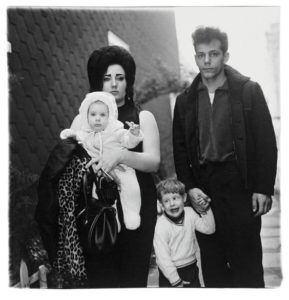A young Brooklyn family going for a Sunday outing, N.Y.C. Arbus, 1966
The fictions we make about photographs are as unreliable as they are unavoidable.(Jobey, 2005)
This review for me started well with this opening statement, it highlights the interpretative nature of ‘reading’ photographs and reflected some of the critiques I have been looking at in terms of semiotics. However, from this point forward I find myself getting increasingly frustrated about what is to me an apparent melange of denotation and connotation with one sometimes being presented as the other.
Jobey starts with a mix of description and interpretation of the image. Highlighting how the viewer might imagine the lives and futures of the family in the photograph – ‘you can’t help wondering what will become of them.’ In the next few sentences it seems clear the assumption of the reviewer is that their futures are not likely to be bright. The review then moves through a series of phases:
- Some background to the image
- Denotation
- Placing Arbus in context and biographical information
- Arbus backstory
- Different perspectives on Arbus’ wider body of work
- Legacy
- Denotation
- Concluding connotation and wider social context
From my perspective the flow is not always clear and moves in and out of the image in an attempt to place both Arbus and the photograph in context. It was not so much the structure that troubled me as some of the statements, which for me blurred the lines between fact and interpretation. Statements like:
- ‘…you can’t help wondering…’
- ‘We pity them partly…’
- ‘…her bland white baby…’
- ‘They look or their marriage looks, already exhausted…’
- ‘What is clear…’
- ‘What is disturbing…’
- ‘…her appearance seems absurd…’
- ‘…its power comes from the ordinariness they dispute…’
I highlight these phrases because of their resoluteness and the sense of assuming I as the reader/viewer am complicit in these understandings. In my case there were several points where I did not make the interpretation apparently being made for me and where I felt unsubstantiated projections were being made. Only a couple of times does Jobey allude to an interpretation by saying ‘his expression suggests’ or ‘it is an extension of the impression given’. At no point does she appear to own her interpretations and place them in the first person.
I appreciate it may seem that there is an impertinence in my critique of Jobey’s essay, it is after all a comprehensive review, but going through this process has helped me in thinking about the importance of language and the recognition of the interpretative nature of semiotics. I needed to understand the source of my irritation in reading some of the passages. It has also highlighted the challenge of making personal interpretations and assuming that they can be generalised, something that other social science research methodologies have been grappling with for years in a way I haven’t yet seen to the same degree in this field.
References:
Jobey, L. (2005). A young Brooklyn family going for a Sunday outing , N.Y.C. 1966. In S. Howarth (Ed.), Singular Images: Essays on remarkable photographs (pp. 67-76). London: Tate Publishing.






















